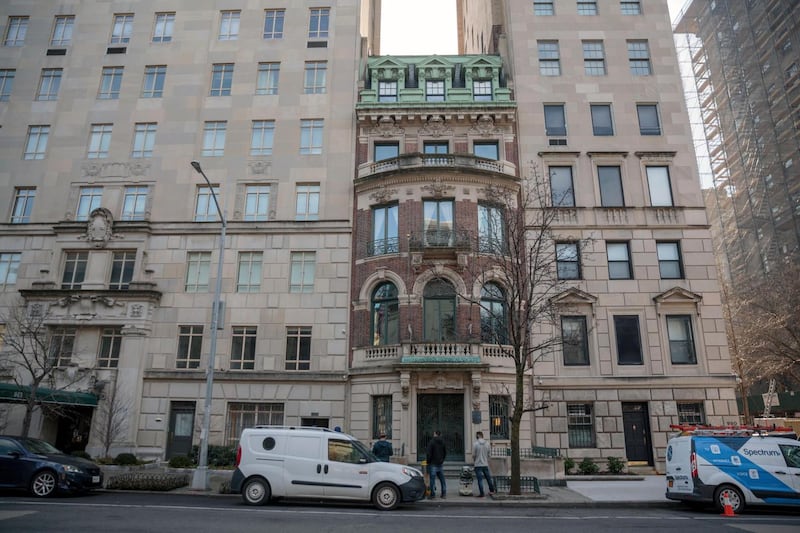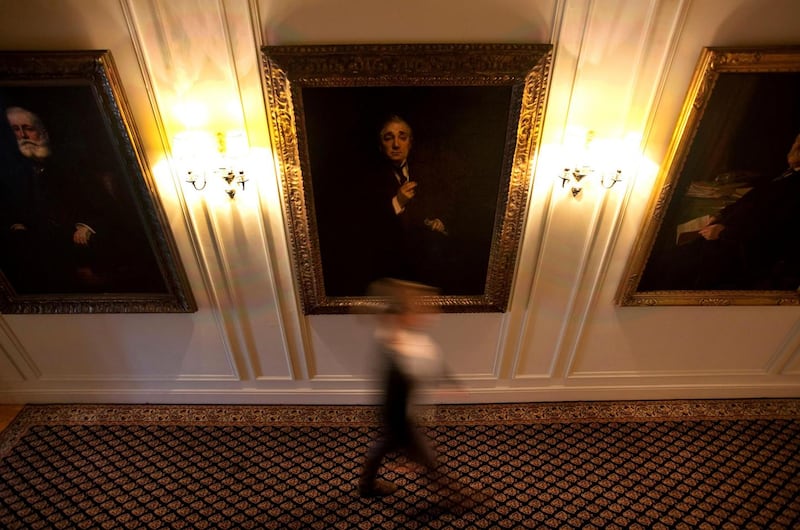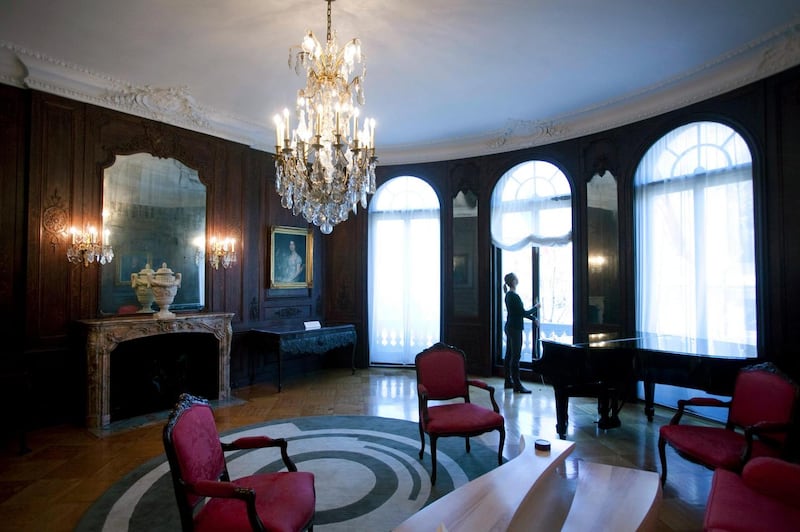An exquisite Gilded Age townhouse on Fifth Avenue in New York City is on the market for more than $52 million, or more than €40 million. It features five storeys, a curved terrace and a history that reads like a tragedy of manners, filled with grandeur and pride, pettiness and decay.
Think Edith Wharton; better yet, think James Joyce. As home to the American Irish Historical Society, the mansion has long symbolised the immigrant ascent of Irish America. The Tricolour and the Stars and Stripes flying from its bowed facade stake a claim to rarefied pavement directly across from the Metropolitan Museum of Art.
But for nearly half a century the building and society have been the fief of an eminent physician named Dr Kevin M Cahill, his family and his friends. Those who ventured to reform its ways have historically been shown the ornate door.
The building on Fifth Avenue is something that stands for all of us. This is about a very small group controlling what is held in trust for the Irish in America and around the world
Now the sudden plan to sell the mansion has exposed the seemingly profound problems beneath its mansard roof – including a very public and allegedly nearly violent confrontation provoked by its executive director, Cahill’s son Christopher – and elevated what might be dismissed as an internal squabble to international embarrassment.
“The building on Fifth Avenue is something that stands for all of us,” says Brian McCabe, a former New York homicide detective and one in a long line of ousted society leaders. “This is about a very small group controlling what is held in trust for the Irish in America and around the world.”
The Irish Government, which has given nearly $1 million, or almost €850,000, to the society since 2008, has publicly decried the proposed sale, while dozens of prominent artists and business leaders have joined nearly 30,000 others in petitioning the New York State attorney general to step in.

Cahill, who is 84, has not responded to requests for comment, but a society board member and long-time friend of the doctor, Guy L Smith IV, dismisses the notion of a Cahill-controlled club. He says the sale will allow the society to preserve its extensive library (in an undetermined location), and he plays down the significance of the mansion the society has called home for 80 years: "The building is not historically related to the Irish experience. It's just a nice building on Fifth Avenue."
The mansion at 991 Fifth Avenue is a confection of its era. Built in 1901 for the widow of a wealthy merchant, it eventually passed hands to a steel magnate who had given New York society the vapours by leaving his wife for a musical-comedy actress. After she left him in turn, he lived alone until his death, upstairs, in 1934.
Several years later the Irish moved in. The American Irish Historical Society had been founded in 1897 to ensure that the Irish contribution to the American experience was duly recognised. It held large gatherings and published a journal that occasionally leaned into grandiose boasts.
The purchase of the Fifth Avenue building, noteworthy enough for Mayor Fiorello La Guardia to speak at its dedication in 1940, provided suitable space for its books and centuries-old artefacts, including a first printing of the Bible in the Irish language, from 1685.

As the years passed, the foundational fervour waned; the society became an afterthought. The scholar and politician Daniel Patrick Moynihan once described its underused mansion as a "great tomb". Then, in the mid-1970s, a physician stepped up to tend to the patient: Cahill, a tropical-disease specialist known for his humanitarian work around the world.
Cahill's resumé includes treating Pope John Paul II after he was shot in 1981; leading a ground-breaking Aids symposium in 1983 that countered the prevailing homophobic indifference; and serving as a special adviser to his friend Hugh Carey, New York's governor from 1975 to 1982. To his admirers the doctor was a healthcare visionary, to some of his critics the embodiment of imperious self-regard.
With Cahill as president-general, the society's profile grew. It held an annual gala at which gold medals were awarded to the likes of President Ronald Reagan, the financier Wilbur Ross jnr and Cahill himself. And every March the doctor donned a morning coat and joined a select group of guests in watching the New York St Patrick's Day parade from the mansion's terrace – until the city shortened the route a decade ago.
The society became a Cahill bastion. The doctor's son Christopher, now 55, was its well-paid executive director, while relatives – including two other sons – and loyalists peppered the board. Around 2012, Cahill asked Thomas Dowling, a partner at Goldman Sachs, to serve as president. Dowling's parents were neighbours and friends of the Cahills when he grew up on Long Island, and he had made substantial donations to the society, including $250,000, or more than €200,000, for a multimillion-dollar restoration of the mansion that had a $3 million, or €2.5 million, overrun.
'Christopher Cahill lunged towards me to hit me,' Ciaran O'Reilly claims. 'He was yelling, I'm going to kill you, Ciaran!' says Kathleen Begala
Despite the “great honour”, Dowling says, he soon came to regard the society as managerially dysfunctional, with limited public purpose or financial transparency. The entire enterprise depended on the success of one event, he claims: its annual gala. “After seeing the shenanigans first-hand,” Dowling says, he and the chair presented a restructuring plan to Cahill. It called for hiring a business manager and reassigning the executive director – the doctor’s son Christopher. “He turned red, got visibly annoyed and said, ‘We’re not going to run it your way; we’re going to run it my way,’” Dowling recalls.
Dowling resigned, as did the chair. A Groundhog Day pattern was emerging. Before long another board member, well established in the business world – Michael Dowling, president and chief executive of Northwell Health, the state's largest healthcare provider – was advocating similar reforms. So was an independent contractor, Harry C Barrett, a former president of New York Medical College.
To no avail. Dowling (no relation to Thomas Dowling) stepped down in disappointment. And Barrett was abruptly fired, after which he expressed baffled sorrow that his efforts to address the “old ways” were “so utterly defeated”. Smith, the society representative, does not deny that a succession of experienced administrators had raised alarms. But he says they left for failing to raise enough money for the annual dinner – a charge that others vehemently dispute. “It just didn’t work,” Smith says. “The society moved on.”
In 2016 the insular society agreed to open the mansion for an Irish Repertory Theatre production of The Dead, 1904. The play, adapted from the James Joyce short story by the Irish poet Paul Muldoon and his wife, the author Jean Hanff Korelitz, placed the audience amid a post-Christmas gathering in Edwardian-era Dublin.

The well-received seven-week production generated €79,000, or more than €66,000, for the society, showed off its building to celebrities and the well-heeled, and fulfilled the goal of promoting Irish culture. Staged again in 2017 and 2018, the play was on the cusp of becoming a holiday tradition.
But in January 2019, during an after-party celebrating the season's final performance, there was an incident. An apparently agitated Christopher Cahill rushed down the mansion's balustraded stairwell and made a beeline for Ciaran O'Reilly, the play's director and cofounder of the theatre.
"He lunged towards me to hit me," O'Reilly claims. "He was yelling, 'I'm going to kill you, Ciaran!'" recalls Kathleen Begala, the theatre company's chair. When she stepped in front of him, she alleges, Cahill threatened her as well, after which he was restrained and escorted to the lobby. Cahill has not answered requests for comment.
Smith says the executive director's behaviour had been prompted by his interpretation – a misinterpretation, it turned out – of how long the Irish Repertory could linger after the last performance. "The response from Chris was overly exuberant," he says. By this point the society's new president, a lawyer named James Normile, and its new chair, McCabe, the former detective, had already resurrected the familiar call for urgent reorganisation. The society, McCabe later wrote, "was in disarray", with a $3 million loan owed to one board member.
Their plan called for hiring a director of business and development. Christopher Cahill would be required to seek counselling and assume the reduced role of director of cultural and archival affairs – a plan he agreed to in a letter. The Irish Government, which had given the society $934,000, or more than €780,000, over the previous decade, also signed on to what it viewed as a much-needed restructuring plan. It agreed to provide $50,000, or more than €40,000, for the new business position.
The American Irish Historical Society has suggested that Ireland buy the building. Meanwhile, various Irish Americans of means are standing in the wings to salvage the building and, by extension, the society
But the plan for reform blew up. Again. First, an emissary of the Cahill-controlled board notified Normile that he had been removed as president. (“I almost threw him out of my office,” he says.) After that, McCabe – whom the society had recently applauded for making the 2018 gala a success – was ousted as chair. “A series of governance lapses by Mr Normile and Mr McCabe,” Smith explains.
Also terminated: the new business director, David O’Sullivan, who had presented a plan for revenue streams that included opening the building to exhibitions and special events such as weddings. “This never appealed to the Cahills,” he says. “They always wanted to keep the doors locked.” Smith says O’Sullivan had been fired because he had “tanked” the upcoming gala by sharing internal documents that tipped off the would-be honouree to the society’s struggles, after which the businessman declined the honour. O’Sullivan scoffs at this, saying the strife was already public knowledge.
Taken aback by the turmoil, the Irish Government halted payment for the new position and exercised its contractual right to audit the society’s books. Smith says the audit merely “had some suggestions of governance”; the Irish Consulate in New York, though, says the review had identified “significant issues”.

Meanwhile, McCabe and Normile asked the state attorney general’s charity bureau, which oversees nonprofit organisations, to intervene. (McCabe says he was in contact with the bureau and that its inquiry remains open. A spokesperson for the attorney general declines to say whether the office is investigating the society.)
The fallout continued. The society, now fully returned to Cahill control, notified the Irish Repertory that the mansion would not be available for a fourth season of The Dead, 1904 – even though O’Sullivan had negotiated a deal that would have increased revenue and exposure for the society.
When asked why the society killed the event, Smith responds that “it was determined that it would not work for the society”. In late January, after a year of pandemic-related inactivity, the society put its rare jewel of a mansion on the market. “One for the ages,” trumpeted the real-estate firm handling the sale. Akin to “acquiring the Holy Grail”.
The news horrified the Irish-American community, prompting many to call on the attorney general to halt the sale. Under state law, the sale of property by a nonprofit organisation is contingent on the approval of the attorney general or the State Supreme Court.
The Oireachtas Committee on Foreign Affairs and Minister for Foreign Affairs Simon Coveney urged the society to reconsider. The building, Coveney says, is "an iconic emblem of Ireland in New York". The society responded to the committee this past week with a suggestion that Ireland buy the building. Meanwhile, various Irish Americans of means are standing in the wings to salvage the building and, by extension, the society.
“There is enthusiasm to fix it,” Thomas Dowling says. “But there will be hesitation until the society has sound leadership and sound governance.” For now the repository of a culture at 991 Fifth Avenue remains closed. And the Irish and American flags that once bracketed its Gilded Age entryway have been removed. – New York Times









